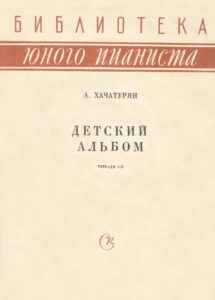Table of Contents:
A. Khachaturian. Concerto for piano and orchestra (complete)
Moscow City Symphony – Russian Philharmonic
Conductor — Fabio Mastrangelo (Italy)
Soloist — Boris Berezovsky (piano)
Grand Hall of the Conservatory
March 4, 2014
Симфонический оркестр Москвы «Русская филармония»
Дирижер — Фабио Мастранджело (Италия)
Солист — Борис Березовский (фортепиано)
Большой зал консерватории
04.03.2014
А. Хачатурян. Концерт для фортепиано с оркестром, части 2 и 3
‘I was brought up surrounded by rich folklore. This is how my way of thinking was born.’
Aram Khachaturian
Browse in the Library:
and subscribe to our social channels for news and music updates:
A. Khachaturian Concerto for piano and orchestra (First Mov.)
A. Khachaturian Concerto for piano and orchestra (2nd and 3rd Movts.)
Download Khachaturian’s sheet music from our Library.

Khachaturian’s Piano Concerto
Although Aram Khachaturian is revered in the Soviet Union for a large body of music, his fame in the West is based largely on a mere handful of works, among which is the Piano Concerto.
The concerto’s widespread appeal is at once understandable, given its virtuosic flair, honest, unabashedly passionate melodic sense, and rich orchestration, all in the Russian Romantic manner of Tchaikovsky and Rachmaninoff.
Best Sheet Music download from our Library.
The opening movement of the concerto is cast in a somewhat loose sonata form, the impatient main theme developing almost immediately upon its appearance. Out of this sonic mass the secondary material arises and evolves into a powerful, cerebral monologue for the soloist before the furious development leads into an exuberant, headstrong cadenza. The primary theme returns in force as the subject of the coda. – The second movement begins with a dignified melody, introduced by the bass clarinet. The dramatic heart of the movement is the middle section, a potent combination of oriental flavoring and turbulent Russian drama that builds to an ecstatic climax. The movement is rounded out by a return of the introductory material.
The far-reaching, virtuosic Allegro brillante finale is built around contrasting themes and an outrageous, bravura cadenza. The concerto comes to a close with the return, on a grand scale, of material from the first movement. The concerto is dedicated “To Lev Oborin”.
3 things you should know about Aram Khachaturian
1. He was a Late Starter
Born in Georgia to a family of Armenian craftsmen, Aram Khachaturian was not destined for a musical career. It was not until the age of 22 that his musical training flourished and he joined the composition class at the Gnessine Musical Institute, whilst continuing his scientific studies at university. He quickly became the best student and one of the few admitted to the Moscow Conservatory where he learnt composition under Nicholas Myakovsky. Sergei Prokofiev was so impressed by Khachaturian that he sent Khachaturian’s Trio for Clarinet with his son to be performed in Paris!
2. He was inspired by folklore
Khachaturian is widely known for his use of folk music in his compositions. Deeply attached to national cultures, he was inspired by the folklore of all the republics of the Soviet Union, especially Armenia and Georgia. His melodies are characterised by improvisations, variations and the imitation of oriental timbres. They permeate the majority of his compositions, like the Toccata or his ballet Gayane (1942), which features the famous “Sabre Dance.”
3. He was Denounced!
Like Prokofiev and Shostakovich, Khachaturian was a representative of the USSR abroad. He composed the Song of Stalin and the Ode to the Memory of Lenin. Yet in 1948, despite a public apology, he was denounced alongside Shostakovich and Prokofiev for an excess of formalism in his music and sent to Armenia to be “re-educated”. This condemnation ended at the death of Stalin, and when he returned to Moscow he did not change his compositional style, composing Spartacus, a world-renowned ballet.
Occasionally one to make a scene, Khachaturian once stormed out of the Yerevan Opera during a performance of Spartacus because the conductor had cut four bars of his music!

A. Khachaturian. Concerto for piano and orchestra (complete) with sheet music
Piano Concerto in D flat major, written in 1936.
00:00 – I. Allegro ma non troppo e maestoso
15:11 – II. Andante con anima
26:03 – III. Allegro brillante